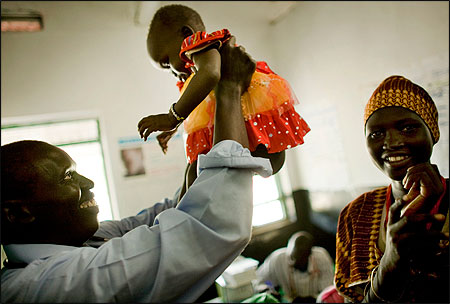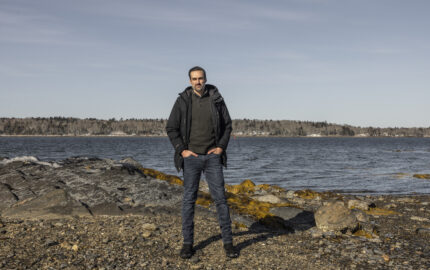
Visual Journalism
Photojournalism is changing, propelled by newsroom budget cuts, multimedia possibilities, and the ubiquity of digital images. In Visual Journalism, photojournalists write about emerging digital business strategies and their efforts to expand the reach of their photographs online and on gallery walls. They also share ideas about how to fund projects of personal passion and societal value. Their words tell vital stories about how they do their work; slideshows of their photographs—exclusive to our Web site—and multimedia presentations convey their visual stories. Read and watch as the future of photojournalism unfolds.

Dr. Benjamin Mach, one of the “Lost Boys” physicians, visits with a child during a weeklong clinic at Akobo Hospital in southeastern Sudan. Photo ©Wéyo.
People say I’m an idealist, and I guess I am. Perhaps that is why I became a journalist two decades ago. And maybe it’s part of the reason that in 2008 I left a great full-time job as a photojournalist at The Virginian-Pilot in Norfolk, Virginia, a newspaper with a well-established reputation for embracing narrative—and visual—storytelling, to head off in a new direction.
So why did I leave? My goal was to launch a media and design company with a clientele of nonprofits for whom I and other photographers would shoot pictures they needed to get their message out. It would be a different way of using photojournalism to tell vital stories about people and places in need of public awareness. Of course, my start-up soon collided with the nation’s debilitating recession. My poor timing was confounded by the reality that most nonprofits didn’t have much of a budget for marketing, even in the best of times.
Was I stupid or passionate? Take your pick, but I’ve always believed that success will happen when passion and inspiration collide. With the launch of Wéyo, those ingredients are present in abundance.
Even in my newspaper work, I was drawn to stories that held out the possibility that awareness could bring about change. I especially liked those focused on inequities. Ideas for stories came to me in the course of street reporting or reflected my small town upbringing in rural western Virginia. And after I saw how some of my published images influenced legislation or helped to find homes for those without or brought hope to those suffering with an illness, I was hooked. I knew this potential could be realized.
My desire to convey compelling images was what drove my work as a journalist. Yet as years went by I became less certain that working for a newspaper was the best way for me to do what was in my blood. Journalism seemed to be less about public service and raising awareness and more about giving readers the infotainment they craved. Over time it became clear that either my newspaper or me would have to change course.
Wheels Start Turning
Then in 2004 I had lunch with a friend from National Geographic. We talked about how the magazine industry was changing and a lot of photojournalists were finding it difficult to get their pictures published at places where their work had been much in demand only a short time ago. Even though my newspaper still published my work, it seemed only a matter of time before these trends would hit closer to home.
In 2007 I met a kindred spirit, photojournalist Stephen Katz. He’d returned to the States from Nigeria after doing some pro bono work for Physicians for Peace, a nonprofit based in Norfolk, Virginia. His images were incredible, but what really caught my attention was how he had captured them. Turns out that he had talked his way inside of a mental hospital, if it could charitably be called that, to photograph the inhumane ways patients were being treated. What he showed me was haunting; taken together, theses picture told a vitally important story. Yet he told me that no news organization was interested in publishing them.
It was hard for me to connect these two thoughts. On one hand, I couldn’t stop looking at his photographs; on the other, what Stephen was telling me meant that few others would ever see them. This realization led to me to explore in more depth whether this was happening to other photographers and if so, why and what could be done to bring these images to public awareness.
Here’s what I learned: There are hundreds of nonprofits and nongovernmental organizations (NGOs) doing remarkable work in troubled regions throughout the world to make better the lives of people who are mentally ill, homeless, disenfranchised or are dealing with a host of other all too familiar problems. Most of these nonprofits and NGOs don’t have the people onboard who are able to bring to their outreach efforts and their Web sites a compelling visual display of their initiatives and efforts. Yet these are precisely the kind of images that Stephen and I have the skill and desire to shoot.
Creating a business connection between what we want to do and what organizations like these need seemed an obvious direction for us to head. In thinking about setting up such an enterprise, we knew that nonprofits, especially small ones, are perpetually short on financial resources and the money they raise is targeted at providing services. We found instances when writers and photographers donated words and visuals; even so, we quickly recognized the challenge that these small nonprofits confront in figuring out how to use visual material effectively to communicate the importance of their work.
So Stephen and I did what two idealistic photojournalists would do. We sat down for a sushi dinner and started to select the building blocks to construct what would be our new business. Its name is Wéyo. In Haitian Kréyol, Wéyo is “to see them.” While unusual for a company name, its fit was perfect for us. We had gone to Haiti in early 2008 to produce pro bono a documentary video for Physicians for Peace, and it was there, in a steamy, pungent hospital room that our passion joined forces with our inspiration.
Starting ‘To See Them’
In Haiti, we’d found our name. Back in the United States, we founded our company. The idea was to capitalize on our collective years of journalism experience and turn our narrative storytelling abilities toward work with nonprofits. We envisioned that our photographs, videos and narrative text would be used to design Web sites and other marketing products as a way to bolster fundraising and attract volunteers. As we got underway, we found ourselves in the company of other writers, designers and editors of amazing talent who, like us, were alarmed by the changes taking place in journalism. Some decided to join us at Wéyo, and together we formed the company’s nucleus and designed a roundtable approach to our projects to make best use of our varied special talents.
By late 2008, we had our first contract working with a local children’s hospice to produce content and develop a new Web site. Later that year we produced for a Web site, TreeofLives.org, a short segment that also aired on the Christian Broadcasting Network. Within a week our efforts to tell this visual story had garnered Tree of Lives more than $15,000.
RELATED ARTICLE
"‘Lost Boys’ Return to Sudan as Doctors"
- Christopher TyreeWe also produced and published a story for Need magazine about a group of “Lost Boys” who had immigrated to Canada and now were returning home to the Sudan to work as physicians. Samaritan’s Purse Canada, which supported these young men’s education and journey home, used our video as a fundraising tool to aid these doctors.
- In the editing process, we were at the mercy of our clients, who we knew from the start had a difficult time figuring out how best to tell their own stories. As a result, some of our projects lost their intensity as we were forced to edit out some of the power, heart and creativity that we felt strengthened the stories and believed would have motivated donors and volunteers.
- Historically, small and even mid-sized nonprofits have had very little experience in marketing. We discovered that in many cases we had to devote an equal amount of time learning about these organizations and teaching them how to tell their stories in emotionally powerful ways as we did producing the visual material.
So far Wéyo’s operations have been sustained on the initial investments that Stephen and I contributed. Add to that our passion, many sleepless nights, and too-many-to-count volunteer hours from many of our team members, and the formula for what keeps us going emerges. Even with what we’ve been told is an attractive business plan, we can find few potential investors who are willing to take a risk on a start-up like ours that is working for cash-strapped nonprofits during these tough economic times. And banks will not consider lending us money until we’ve been in business for at least three years.
Despite our economic peril, we’re doing precisely the work we set out to do—the work we feel we’re trained to do and work that we believe matters, despite our meager profit. Still, we know it’s time to take our company in a different direction—one that is increasingly familiar to our photojournalist colleagues as they find places for what they do in emerging pockets of nonprofit journalism, much of it happening on the Web.
Wéyo needs to become a nonprofit so that we can keep doing what we’re doing. As a nonprofit, we will continue our same collaborations with other nonprofits and NGOs. Our goal is the same as when we ate that sushi dinner and discussed our vision for what would become Wéyo. Taking all we’ve learned as photojournalists, we are now finding new ways to harness the power of visual narratives in work with our nonprofit clients. Pairing these projects with a variety of digital platforms, we can bring stories of triumph and despair, stories about the challenges people face and the help they receive, to new audiences.
Without taking the chance we have with Wéyo, I’m convinced that a lot of these stories would remain untold. We intend to do what we can to tell them.
Christopher Tyree is the president and CFO of Wéyo Inc.


